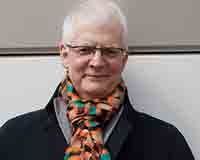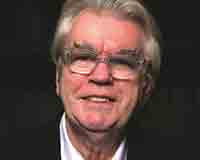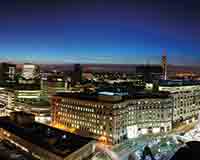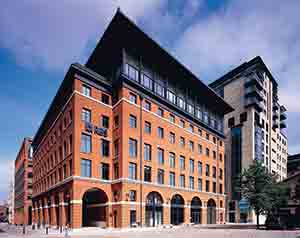For many who grew up in the post-war era, Birmingham was synonymous with failing industry and bold, but flawed, road-dominated regeneration plans. Now, with HSBC moving in, Deutsche Bank already settled and high-speed rail on the horizon, investment is pouring into Birmingham and opportunity for reinvention is emerging.
As bold architecture is part of the Big City Plan, EG speaks to three leading architects – two of whom are proud Brummies – and asks them what the city needs in terms of design.
 Glenn Howells
Glenn Howells
A born-and-bred Brummie, Howells has an eponymous architecture practice in the city and is best known for his work on Paradise Circus and Arena Central.
How do you view Birmingham?
I love this city. From Joseph Chamberlain’s time in the 19th century, onward, the motto on the city’s coat of arms has been “Forward”. A century-and-a-half later we are on the cusp of a new wave of investment and growth, not just led by HS2, but from a realisation that Birmingham’s ingredients – its population, proximity to London, connectivity, creativity and liveability – makes it an inevitable investment hotspot. The standard of development has been mixed. Some have been excellent, like Brindleyplace. Other developments have overly focused on landmark buildings rather than the overall context. We need to reinforce the public spaces and we need far fewer roads and car parks. Public spaces will heal the scars left by the inner-city motorway. We shouldn’t be proud that Birmingham is our most car-friendly city.
The collection of 19th-century buildings around Chamberlain Square, with the town hall centrepiece, is terrific. And the art school in Margaret Street is a masterpiece of terracotta and brick. Alpha Tower is an elegant building that has weathered well. More recently, I think Brindleyplace (pictured) works very well.
Least favourite building and why?
The central post office built near New Street station in the 1980s. It is one of those post-modern buildings that looked tired as soon as it was finished. It has a mean, flat façcade that lacks any quality or depth.
How is design evolving and what will we see more of in the future?
We will see a greater focus on density. We need to work now to repair the urban grain with more Victorian, cheek-by-jowl density. The fact that Birmingham has not developed many of the large sites near its centre means it has more potential than any city I know.
Many types of buildings are needed, from new, large high-quality homes within walking distance of the city centre, to interesting small-scale workspace for creative industries and large, flexible offices for firms such as Deutsche Bank and HSBC.
Does the city inspire you?
Totally. Not because of what it looks like now but because of the opportunities it offers, and because of the people in it.
Somehow the city has never lost the imagination and drive to invent and make things. It still lives up to its motto.
 Ken Shuttleworth
Ken Shuttleworth
Ken Shuttleworth is perhaps best known as the pen behind the Gherkin in London. But this Brum-born boy has never forgotten his roots and has designed two of Birmingham’s iconic buildings, The Cube and 1 Arena Central.
How do you view Birmingham?
Birmingham is one of the great cities of the world and my home town. Maybe too much was knocked down in the 1950s and 1960s, but most of what went were slums. The standard of current design is pretty high. The Library of Birmingham is amazing and the Future Systems [Selfridges] building. While, the [New Street station] signal box is pretty uncompromising, it is brilliantly brutal.
There aren’t really any great iconic buildings, but there is plenty of room for them.
Is the negative image that some have of Birmingham justified?
Connectivity between the centre and outlying areas is not fantastic. The concrete collar, which is now thankfully being demolished, had strangled the city centre.
When I was a kid you could look out of your window and see the smoke and the machines going. That became a wasteland, a ring of hollowness which needs improving with parks and trees. More pedestrian infrastructure, greenery and more love are needed. It needs to be a more beautiful place.
Favourite Brummie buildings?
I have a lot of love for the industrial buildings. I also loved the old John Madin library – the one that’s going to be demolished. The stuff being built when I was growing up, like the Rotunda, was fantastic. And it has evolved with the Urban Splash scheme. And Brindleyplace, of course.
Least favourite building and why?
The city needs more buildings that could only be built in Birmingham, rather than the bland and generic glass boxes that could be anywhere. If you use a formula that you have done somewhere else, you aren’t doing justice to Birmingham.
And I would take a bulldozer down New Street to take out the signage and the kiosks. Put in trees. Make it a boulevard.
How is design evolving and what will we see more of in the future?
Birmingham needs to be intensified, more dense. If you go to the top floor of The Cube and look out of the window, it’s pretty low density and a big spread. I do fear for that.
Does the city inspire you?
It does, even though I haven’t lived there for years. If something comes up in Birmingham I will always have a go at trying to get it.
Growing up in Birmingham was my greatest inspiration for becoming an architect. I used to look out of my window at the smoke stacks of the factories and this new city being made.
 Sir Terry Farrell
Sir Terry Farrell
A native of Newcastle, Sir Terry Farrell is, however, responsible for one of Birmingham’s most influential pieces of architecture and planning, Brindleyplace.
How do you view Birmingham?
The city is sometimes maligned by those unaware of its past. Or they are distracted by the poor public realm and road infrastructure. There is no doubt Birmingham was a great city and is becoming great again. We must reconnect the city to its sense of place, and reuse historic elements to inform the direction of its future development.
Is the negative image that some have of Birmingham justified?
The negative image of Birmingham is unjustified, but rather hard to shake off. Perhaps it stems from the visitor’s initial impression of roads dominating the city centre, and the idea (since superseded) of industrial wasteland. The city’s former greatness also makes its character hard to summarise as a snapshot.
Favourite Brummie buildings?
Architectural gems include the Soanian Regency House on Waterloo Street, Philip Hardwick’s abandoned Curzon Street railway station, the Victoria Law Courts on Corporation Street, and the University of Birmingham buildings.
I admire the dynamism of the Selfridges building, but I have concerns that some of the new architecture lacks a sufficiently contextual response, which creates a more undifferentiated city that then takes away more context and risks the city losing what makes it unique.
Least favourite building and why?
The Castle Vale housing estate has now mercifully been regenerated. But the various glass monoliths in the city centre are its similar successors – they erode, rather than add, distinctiveness. The real problem is Birmingham is still dominated by roads, roundabouts, flyovers, slip lanes, and other urban graffiti.
How is design evolving and what will we see more of in the future?
There should be less of an emphasis on signature buildings. There is a need for background and street buildings to re-establish the civic fabric, which might otherwise be in danger of erosion.
Does the city inspire you?
Birmingham is poised to re-emerge as a base to supplement London. It can also, with HS2, form a staging post between the South East and the northern powerhouse. It is an inspiring city, and there are surprises and juxtapositions – many of which are welcome.












